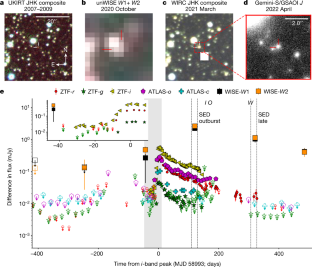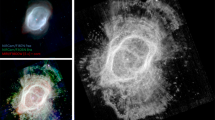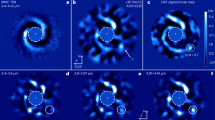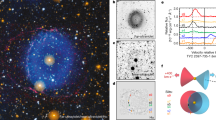Abstract
Planets with short orbital periods (roughly under 10 days) are common around stars like the Sun1,2. Stars expand as they evolve and thus we expect their close planetary companions to be engulfed, possibly powering luminous mass ejections from the host star3,4,5. However, this phase has never been directly observed. Here we report observations of ZTF SLRN-2020, a short-lived optical outburst in the Galactic disk accompanied by bright and long-lived infrared emission. The resulting light curve and spectra share striking similarities with those of red novae6,7—a class of eruptions now confirmed8 to arise from mergers of binary stars. Its exceptionally low optical luminosity (approximately 1035 erg s−1) and radiated energy (approximately 6.5 × 1041 erg) point to the engulfment of a planet of fewer than roughly ten Jupiter masses by its Sun-like host star. We estimate the Galactic rate of such subluminous red novae to be roughly between 0.1 and several per year. Future Galactic plane surveys should routinely identify these, showing the demographics of planetary engulfment and the ultimate fate of planets in the inner Solar System.
This is a preview of subscription content, access via your institution
Access options
Access Nature and 54 other Nature Portfolio journals
Get Nature+, our best-value online-access subscription
$29.99 / 30 days
cancel any time
Subscribe to this journal
Receive 51 print issues and online access
$199.00 per year
only $3.90 per issue
Buy this article
- Purchase on Springer Link
- Instant access to full article PDF
Prices may be subject to local taxes which are calculated during checkout




Similar content being viewed by others
Data availability
All the data used in this work are provided in Extended data.
Code availability
K.D. will provide python code used to analyse the observations, and any data used to generate figures, on request. The RLOF code used to model the pre-outburst light curve is publicly available.
References
Winn, J. N. & Fabrycky, D. C. The occurrence and architecture of exoplanetary systems. Ann. Rev. Astron. Astrophys. 53, 409–447 (2015).
Dawson, R. I. & Johnson, J. A. Origins of hot Jupiters. Ann. Rev. Astron. Astrophys. 56, 175–221 (2018).
Metzger, B. D., Giannios, D. & Spiegel, D. S. Optical and X-ray transients from planet-star mergers. Mon. Not. R. Astron. Soc. 425, 2778–2798 (2012).
MacLeod, M., Cantiello, M. & Soares-Furtado, M. Planetary engulfment in the Hertzsprung-Russell Diagram. Astrophys. J. 853, L1 (2018).
Stephan, A. P., Naoz, S., Gaudi, B. S. & Salas, J. M. Eating planets for lunch and dinner: signatures of planet consumption by evolving stars. Astrophys. J. 889, 45 (2020).
Ivanova, N., Justham, S., Avendano Nandez, J. L. & Lombardi, J. C. Identification of the long-sought common-envelope events. Science 339, 433 (2013).
Matsumoto, T. & Metzger, B. D. Light curve model for luminous red novae and inferences about the ejecta of stellar mergers. Astrophys. J. 938, 5 (2022).
Tylenda, R. et al. V1309 Scorpii: merger of a contact binary. Astron. Astrophys. 528, A114 (2011).
Bellm, E. C. et al. The Zwicky Transient Facility: system overview, performance, and first results. Publ. Astron. Soc. Pac. 131, 018002 (2019).
Warner, B. Cataclysmic Variable Stars (Cambridge Univ. Press, 1995).
Gehrels, N. et al. The Swift Gamma-Ray Burst Mission. Astrophys. J. 611, 1005–1020 (2004).
Corral-Santana, J. M. et al. BlackCAT: a catalogue of stellar-mass black holes in X-ray transients. Astron. Astrophys. 587, A61 (2016).
Popov, D. V. An analytical model for the plateau stage of type II supernovae. Astrophys. J. 414, 712 (1993).
Rich, R. M., Mould, J., Picard, A., Frogel, J. A. & Davies, R. Luminous M giants in the bulge of M31. Astrophys. J. 341, L51 (1989).
Martini, P. et al. Nova Sagittarii 1994 1 (V4332 Sagittarii): the discovery and evolution of an unusual luminous red variable star. Astron. J. 118, 1034–1042 (1999).
Munari, U. et al. The mysterious eruption of V838 Mon. Astron. Astrophys. 389, L51–L56 (2002).
Tylenda, R. et al. OGLE-2002-BLG-360: from a gravitational microlensing candidate to an overlooked red transient. Astron. Astrophys. 555, A16 (2013).
Loebman, S. R. et al. The continued optical to mid-infrared evolution of V838 Monocerotis. Astron. J. 149, 17 (2015).
Tylenda, R. & Kamiński, T. Evolution of the stellar-merger red nova V1309 Scorpii: spectral energy distribution analysis. Astron. Astrophys. 592, A134 (2016).
Lawrence, A. et al. The UKIRT Infrared Deep Sky Survey (UKIDSS). Mon. Not. R. Astron. Soc. 379, 1599–1617 (2007).
Nandez, J. L. A., Ivanova, N. & Lombardi Jr, J. C. V1309 Sco–understanding a merger. Astrophys. J. 786, 39 (2014).
Pejcha, O. Burying a binary: dynamical mass loss and a continuous optically thick outflow explain the candidate stellar merger V1309 Scorpii. Astrophys. J. 788, 22 (2014).
Zhu, L.-Y., Zhao, E.-G. & Zhou, X. A low-mass-ratio and deep contact binary as the progenitor of the merger V1309 Sco. Res. Astron. Astrophys. 16, 68 (2016).
Pejcha, O., Metzger, B. D., Tyles, J. G. & Tomida, K. Pre-explosion spiral mass loss of a binary star merger. Astrophys. J. 850, 59 (2017).
MacLeod, M. & Loeb, A. Runaway coalescence of pre-common-envelope stellar binaries. Astrophys. J. 893, 106 (2020).
Hellier, C. et al. An orbital period of 0.94 days for the hot-Jupiter planet WASP-18b. Nature 460, 1098–1100 (2009).
Staff, J. E., De Marco, O., Wood, P., Galaviz, P. & Passy, J.-C. Hydrodynamic simulations of the interaction between giant stars and planets. Mon. Not. R. Astron. Soc. 458, 832–844 (2016).
MacLeod, M., Ostriker, E. C. & Stone, J. M. Bound outflows, unbound ejecta, and the shaping of bipolar remnants during stellar coalescence. Astrophys. J. 868, 136 (2018).
MacLeod, M. & Loeb, A. Pre-common-envelope mass loss from coalescing binary systems. Astrophys. J. 895, 29 (2020).
Udry, S. & Santos, N. C. Statistical properties of exoplanets. Ann. Rev. Astron. Astrophys. 45, 397–439 (2007).
Wright, J. T. et al. The frequency of hot Jupiters orbiting nearby solar-type stars. Astrophys. J. 753, 160 (2012).
Hut, P. Tidal evolution in close binary systems. Astron. Astrophys. 99, 126–140 (1981).
Mardling, R. A. & Lin, D. N. C. Calculating the tidal, spin, and dynamical evolution of extrasolar planetary systems. Astrophys. J. 573, 829–844 (2002).
Patra, K. C. et al. The continuing search for evidence of tidal orbital decay of hot Jupiters. Astron. J. 159, 150 (2020).
Yee, S. W. et al. The orbit of WASP-12b is decaying. Astrophys. J. 888, L5 (2020).
Hamer, J. H. & Schlaufman, K. C. Hot Jupiters are destroyed by tides while their host stars are on the main sequence. Astron. J. 158, 190 (2019).
Hamer, J. H. & Schlaufman, K. C. Ultra-short-period planets are stable against tidal inspiral. Astron. J. 160, 138 (2020).
Johnson, J. A. et al. Retired A stars and their companions: exoplanets orbiting three intermediate-mass subgiants. Astrophys. J. 665, 785–793 (2007).
Schlaufman, K. C. & Winn, J. N. Evidence for the tidal destruction of hot Jupiters by subgiant stars. Astrophys. J. 772, 143 (2013).
Grunblatt, S. K. et al. Giant planet occurrence within 0.2 au of low-luminosity red giant branch stars with K2. Astron. J. 158, 227 (2019).
Metzger, B. D., Shen, K. J. & Stone, N. Secular dimming of KIC 8462852 following its consumption of a planet. Mon. Not. R. Astron. Soc. 468, 4399–4407 (2017).
Sandquist, E., Taam, R. E., Lin, D. N. C. & Burkert, A. Planet consumption and stellar metallicity enhancements. Astrophys. J. 506, L65–L68 (1998).
Soares-Furtado, M., Cantiello, M., MacLeod, M. & Ness, M. K. Lithium enrichment signatures of planetary engulfment events in evolved stars. Astron. J. 162, 273 (2021).
Spina, L. et al. Chemical evidence for planetary ingestion in a quarter of Sun-like stars. Nat. Astron. 5, 1163–1169 (2021).
Soker, N. Can planets influence the horizontal branch morphology? Astron. J. 116, 1308–1313 (1998).
Aguilera-Gómez, C., Chanamé, J., Pinsonneault, M. H. & Carlberg, J. K. On lithium-rich red giants. I. Engulfment of substellar companions. Astrophys. J. 829, 127 (2016).
Qureshi, A., Naoz, S. & Shkolnik, E. L. Signature of planetary mergers on stellar spins. Astrophys. J. 864, 65 (2018).
Tonry, J. L. et al. ATLAS: a high-cadence all-sky survey system. Publ. Astron. Soc. Pac. 130, 064505 (2018).
Mainzer, A. et al. Initial performance of the NEOWISE Reactivation Mission. Astrophys. J. 792, 30 (2014).
Fitzpatrick, E. L. Correcting for the effects of interstellar extinction. Publ. Astron. Soc. Pac. 111, 63–75 (1999).
Crause, L. A. et al. The post-outburst photometric behaviour of V838 Mon. Mon. Not. R. Astron. Soc. 341, 785–791 (2003).
MacLeod, M. et al. Lessons from the onset of a common envelope episode: the remarkable M31 2015 luminous red nova outburst. Astrophys. J. 835, 282 (2017).
Blagorodnova, N. et al. Progenitor, precursor, and evolution of the dusty remnant of the stellar merger M31-LRN-2015. Mon. Not. R. Astron. Soc. 496, 5503–5517 (2020).
Pastorello, A. et al. Forbidden hugs in pandemic times. I. Luminous red nova AT 2019zhd, a new merger in M 31. Astron. Astrophys. 646, A119 (2021).
Pastorello, A. et al. Luminous red novae: stellar mergers or giant eruptions? Astron. Astrophys. 630, A75 (2019).
Pastorello, A. et al. The evolution of luminous red nova AT 2017jfs in NGC 4470. Astron. Astrophys. 625, L8 (2019).
Cai, Y. Z. et al. The transitional gap transient AT 2018hso: new insights into the luminous red nova phenomenon. Astron. Astrophys. 632, L6 (2019).
Pastorello, A. et al. Forbidden hugs in pandemic times. II. The luminous red nova variety: AT 2020hat and AT 2020kog. Astron. Astrophys. 647, A93 (2021).
Blagorodnova, N. et al. The luminous red nova AT 2018bwo in NGC 45 and its binary yellow supergiant progenitor. Astron. Astrophys. 653, A134 (2021).
De, K. et al. A population of heavily reddened, optically missed novae from Palomar Gattini-IR: constraints on the Galactic nova rate. Astrophys. J. 912, 19 (2021).
Han, Z. et al. Spectroscopic properties of the dwarf nova-type cataclysmic variables observed by LAMOST. Publ. Astron. Soc. Jpn 72, 76 (2020).
Hillenbrand, L. A. et al. Gaia 17bpi: an FU Ori-type outburst. Astrophys. J. 869, 146 (2018).
Hodapp, K. W. et al. The New EXor outburst of ESO-Hα 99 observed by Gaia ATLAS and TESS. Astron. J. 158, 241 (2019).
Herczeg, G. J. et al. The eruption of the candidate young star ASASSN-15QI. Astrophys. J. 831, 133 (2016).
Drimmel, R., Cabrera-Lavers, A. & López-Corredoira, M. A three-dimensional Galactic extinction model. Astron. Astrophys. 409, 205–215 (2003).
Marshall, D. J., Robin, A. C., Reylé, C., Schultheis, M. & Picaud, S. Modelling the Galactic interstellar extinction distribution in three dimensions. Astron. Astrophys. 453, 635–651 (2006).
Green, G. M., Schlafly, E., Zucker, C., Speagle, J. S. & Finkbeiner, D. A 3D dust map based on Gaia, Pan-STARRS 1, and 2MASS. Astrophys. J. 887, 93 (2019).
Acknowledgements
K.D.’s work was supported by NASA through NASA Hubble Fellowship grant no. HST-HF2-51477.001 awarded by the Space Telescope Science Institute, which is operated by the Association of Universities for Research in Astronomy, Inc., for NASA under contract no. NAS5-26555. M.M.’s contributions were supported by the National Science Foundation under grant no. 1909203. A.-C.E. acknowledges support by NASA through NASA Hubble Fellowship grant no. HF2-51434 awarded by the Space Telescope Science Institute, which is operated by the Association of Universities for Research in Astronomy, Inc., for NASA under contract no. NAS5-26555. S.R.K. thanks the Heising-Simons Foundation for supporting his research. We thank B. Metzger, T. Matsumoto, M. Soares-Furtado and J. van Roestel for discussions. The discovery of the optical transient was based on observations obtained with the Samuel Oschin Telescope 48-inch and the 60-inch Telescope at the Palomar Observatory as part of the Zwicky Transient Facility (ZTF) project. ZTF is supported by the National Science Foundation under grant nos. AST-1440341 and AST-2034437, and by a collaboration including Caltech, IPAC, the Weizmann Institute of Science, the Oskar Klein Center at Stockholm University, the University of Maryland, the University of Washington, Deutsches Elektronen-Synchrotron and Humboldt University, Los Alamos National Laboratories, the TANGO Consortium of Taiwan, Trinity College Dublin, the University of Wisconsin at Milwaukee, IN2P3 France, Lawrence Livermore National Laboratories and Lawrence Berkeley National Laboratories. Operations are conducted by COO, IPAC and UW. The ZTF forced-photometry service was funded under Heising-Simons Foundation grant no. 12540303 (PI: Graham). Some of the data presented herein were obtained at the W.M. Keck Observatory, which is operated as a scientific partnership including the California Institute of Technology, the University of California and the National Aeronautics and Space Administration. The Observatory was made possible by the generous financial support of the W.M. Keck Foundation. The Submillimeter Array is a joint project between the Smithsonian Astrophysical Observatory and the Academia Sinica Institute of Astronomy and Astrophysics, and is funded by the Smithsonian Institution and Academia Sinica. The authors wish to recognize and acknowledge the very significant cultural role and reverence that the summit of Mauna Kea has always had within the indigenous Hawaiian community; we are most fortunate to have had the opportunity to conduct observations from this mountain. The National Radio Astronomy Observatory is a facility of the National Science Foundation operated under cooperative agreement by Associated Universities, Inc.
Author information
Authors and Affiliations
Contributions
K.D. identified the object, initiated follow-up observations, carried out the analysis and wrote the manuscript. M.M. and A.L. led the theoretical interpretation of the transient, created the models presented in this work and wrote the manuscript. V.K., J.E.J., A.-C.E., L.A.H., M.M.K. and R.M.L. assisted with optical/IR follow-up observations, data interpretation and analysis. D.C., C.C., E.K., S.R.K., R.S. and A.V. assisted with interpretation of the data. R.D., M.J.G., F.M., M.S.M., R.L.R. and B.R. are builders of the ZTF observing system and contributed to survey operations during the observations presented here. A.M.M. assisted with analysis of NEOWISE data. N.P. and R.T. assisted with acquisition of SMA data and carried out SMA data analysis. L.H.Q.-N. and L.O.S. assisted with acquistion of VLA data and carried out VLA data analysis. All authors contributed to scientific interpretation.
Corresponding author
Ethics declarations
Competing interests
The authors declare no competing interests.
Peer review
Peer review information
Nature thanks Smadar Naoz and the other, anonymous, reviewer(s) for their contribution to the peer review of this work.
Additional information
Publisher’s note Springer Nature remains neutral with regard to jurisdictional claims in published maps and institutional affiliations.
Extended data figures and tables
Extended Data Fig. 1 Comparison of the r and i band light curve of ZTF SLRN-2020 (shown as red and yellow circles respectively, as indicated) to visual light curves of Galactic and extragalactic red novae from the literature.
The light curves have been normalized to peak magnitude. For each comparison object, we indicate the photometric band of the archival light curve in the legend. The comparison objects include V1309 Sco8, OGLE-BLG-36017, V838 Mon51, M31-LRN-201552,53, AT 2019zhd54, NGC 3437-OT55, AT 2017jfs56 and AT 2018hso57. Error bars are shown at 1σ confidence and 5σ upper limits are shown as symbols with downward arrows.
Extended Data Fig. 2 Comparison of the g − r (panel (a)) and r − i (panel (b)) observed color evolution of ZTF SLRN-2020 (shown as squares and circles respectively) to a sample of red novae from the literature that have contemporaneous multi-band coverage during the outburst.
The literature objects include some of the objects shown in Extended Data Fig. 1 in addition to AT 2020hat, AT 2020kog58 and AT 2018bwo59. In each panel, we show a black arrow indicating the estimated shift in the color evolution of ZTF SLRN-2020 accounting for the best estimated line-of-sight extinction. Error bars are shown at 1σ confidence.
Extended Data Fig. 3 Comparison of the optical spectrum of ZTF SLRN-2020 to different types of Galactic transients.
The comparison objects include a classical nova (PGIR 19brv60, in magenta), a dwarf nova (U Gem61 in red), a FU-Ori type young star outburst (Gaia 17bi62 in yellow) and two EXor type young star outbursts (ESO-Hα 9963 in green and ASASSN 15qi64 in blue). The continua of some sources have been reddened to match that of ZTF SLRN-2020 for easier visualization.
Extended Data Fig. 4 Identification of spectroscopic features in the NIR spectra of ZTF SLRN-2020 during and after the outburst.
In each panel, the gray/black lines represent the raw/binned spectrum during the outburst ( ≈ 160 d after peak), while the light brown/brown lines show the raw/binned spectrum obtained after the fading of the infrared transient ( ≈ 690 d after peak). We also show a comparison with the M7-III type star HD 108849 (in red). Prominent atomic and molecular absorption features are marked.
Extended Data Fig. 5 Corner plots showing the model-fit parameters of the MCMC DUSTY modeling of the SED of ZTF SLRN-2020 ≈ 120 days after outburst peak.
The median of the posterior distributions and the corresponding 68% confidence intervals are indicated in the labels, while the same quantities are highlighted with vertical bars in the one dimensional histograms.
Extended Data Fig. 6 Corner plots showing the fit parameters of the MCMC DUSTY modeling of the SED of ZTF SLRN-2020 ≈ 320 days after outburst peak.
The labelling follows the same convention as Extended Data Fig. 5. AV is not used as a free parameter in this fit.
Extended Data Fig. 7 Constraints on the distance to ZTF SLRN-2020 using Galactic three dimensional dust extinction maps.
We show the estimated dust extinction as a function of distance for three different extinction maps published in the literature65,66,67. We also show the 90% confidence interval for the estimated foreground extinction to ZTF SLRN-2020 based on our SED modeling as the magenta shaded region. For each dust extinction map, we show the allowed distance interval within the estimated extinction range with shaded vertical bars in the same color.
Extended Data Fig. 8 The progenitor of ZTF SLRN-2020 in the color magnitude diagram.
For different distances along the Galactic disk, we use available three dimensional extinction maps to de-redden the progenitor photometry fluxes. The results are shown as circles for the D0365 map, squares for the M0666 map and as triangles for the G1967 map. We also show the range of absolute magnitudes allowed by the 90% AV confidence region (from the SED modeling) as blue, red and gray shaded regions respectively (see legend). We also plot stellar evolutionary tracks from the MIST database for stars of initial masses ranging from 0.8−3.0 M⊙. The horizontal bar at the bottom shows the estimated 1σ uncertainty in the H − K color.
Extended Data Fig. 9 Evolution of the SED of ZTF SLRN-2020 progenitor prior to the onset of the optical transient.
The orange points show the optical/IR photometry from ≈ 6−12 years before the outburst. The black points show the evolution of the progenitor in the mid-IR starting ≈ 1.7 years before the transient. Solid points indicate detections while hollow points denote 3σ upper limits. For the −30 d and −244 d epochs, we show the best fit Silicate dust emission model fit using the mid-IR photometry (see text), while we show estimated upper limits to the dust emission using the W2 photometry. For the last epoch, we also show the pre-outburst optical brightening of the progenitor, coincident with the mid-IR source detected in NEOWISE. Error bars are shown at 1σ confidence and 5σ upper limits are shown as symbols with downward arrows.
Supplementary information
Supplementary Information
Supplementary methods, Tables 1 and 2 and references.
Rights and permissions
Springer Nature or its licensor (e.g. a society or other partner) holds exclusive rights to this article under a publishing agreement with the author(s) or other rightsholder(s); author self-archiving of the accepted manuscript version of this article is solely governed by the terms of such publishing agreement and applicable law.
About this article
Cite this article
De, K., MacLeod, M., Karambelkar, V. et al. An infrared transient from a star engulfing a planet. Nature 617, 55–60 (2023). https://doi.org/10.1038/s41586-023-05842-x
Received:
Accepted:
Published:
Issue Date:
DOI: https://doi.org/10.1038/s41586-023-05842-x
This article is cited by
-
Planet swallowed after venturing too close to its star
Nature (2023)
Comments
By submitting a comment you agree to abide by our Terms and Community Guidelines. If you find something abusive or that does not comply with our terms or guidelines please flag it as inappropriate.



